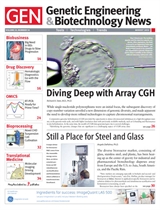Sep 27 2013
The bioinformatics collaboration known as the Pan-Cancer Initiative has released its first findings - genomic alteration profiles for 12 tumor types. The findings - described in two studies and two related commentaries published in the October issue of Nature Genetics - include the identification of many new genomic drivers of cancer.
In the first study, a team lead by Chris Sander, chair of the computational biology program at Memorial Sloan Kettering Cancer Center, provides a hierarchical classification of 3,299 tumors from 12 cancer types from The Cancer Genome Atlas (TCGA) Pan-Cancer dataset, which includes a diverse range of tumor samples from lung, breast, bladder, and brain. The team's paper ("Emerging landscape of oncogenic signatures across human cancers") describes the use of a newly developed algorithmic approach to separate tumors into those with primarily non-germline mutations and those with primarily copy number alterations, in which the cell has an abnormal number of copies of a region of the genome. The authors also identify specific genetic patterns that characterize about 30 tumor subclasses and may suggest therapeutic targets of relevance across tumor types.
In the second study, a team led by Rameen Beroukhim, an assistant professor of medicine at the Dana-Farber Cancer Institute, characterizes non-germline copy number alterations in 11 cancer types and 4,934 primary cancer specimens from the same TCGA Pan-Cancer dataset. In this paper ("Pan-cancer patterns of somatic copy number alteration"), the authors report observing whole-genome doubling in 37% of cancers, associated with higher rates of all non-germline copy number alterations.
In the first commentary ("The Cancer Genome Atlas Pan-Cancer analysis project"), an overview is given by a group of authors led by Joshua Stuart, a professor of biomolecular engineering at the University of California, Santa Cruz. They explain how the project compares similarities and differences among the 12 tumor types profiled by TCGA.
In the second commentary ("Enabling transparent and collaborative computational analysis of 12 tumor types within The Cancer Genome Atlas."), a group of authors led by Larsson Omberg, senior scientist at Sage Bionetworks, discusses the software platform used by the Pan-Cancer groups to share data and collaborate on analysis and results. The use of this software supported the large collaborative efforts in this project, and provides a public resource of highly curated data and automated systems.
Together, the four papers suggest the utility of comparative analyses. They show that while a cancer's tissue of origin is an important factor, a broader look at available data reveals a number of interesting signals that cut across tumor types and suggests new ways of categorizing tumors. In addition, the statistical power gained by combining all of the data available from different tumor types has enabled researchers to see new patterns of genomic aberrations.
"In ovarian cancer, for example, we were able to identify mutations that correlate with the response to treatment, but only by using data from other types of cancer," Stuart said.
A persistent problem in cancer genomics has been distinguishing "driver" mutations from "passenger" mutations. Cancer cells often accumulate large numbers of genetic mutations that do not play a role in driving the uncontrolled cell growth that is a hallmark of cancer. These passenger mutations greatly complicate efforts to identify the genomic drivers of cancer. Aggregating data from the 12 tumor types gave Pan-Cancer researchers enough statistical power to see patterns that weren't apparent before.
The Pan-Cancer analyses have also revealed the importance of new classes of mutations, such as those that affect how a cell's DNA is packaged in the chromosomes. As cells differentiate into specialized cell types during an organism's development, some genes are turned off and others are turned on depending on how the DNA is packaged together with specialized proteins to make chromatin. Genomic changes (gene amplification, deletion or mutation) affecting genes that control the packaging of DNA can disrupt this key regulatory mechanism. The paper by Beroukhim and colleagues analyzed amplifications and deletions and found 104 novel regions that had not been associated with cancer previously, and these regions contain a rich supply of genes involved in epigenetic modifications of chromatin.
"These initial papers are just the first step, and we expect much more to come from the Pan-Cancer Initiative," Stuart said. "With the infrastructure now in place, we can scale up to look at more types of data, especially whole genome sequencing data, and to include many more tumor types, including rare tumors."

 This article was reprinted from Genetic Engineering & Biotechnology News (GEN) with permission from Mary Ann Liebert, Inc., publishers. Genetic Engineering & Biotechnology News (GEN) has retained its position as the number one biotech publisher around the globe since its launch in 1981. GEN publishes a print edition 21 times a year and has additional exclusive editorial content online, like news and analysis as well as blogs, podcasts, webinars, polls, videos, and application notes. GEN's unique news and technology focus includes the entire bioproduct life cycle from early-stage R&D, to applied research including omics, biomarkers, as well as diagnostics, to bioprocessing and commercialization.
This article was reprinted from Genetic Engineering & Biotechnology News (GEN) with permission from Mary Ann Liebert, Inc., publishers. Genetic Engineering & Biotechnology News (GEN) has retained its position as the number one biotech publisher around the globe since its launch in 1981. GEN publishes a print edition 21 times a year and has additional exclusive editorial content online, like news and analysis as well as blogs, podcasts, webinars, polls, videos, and application notes. GEN's unique news and technology focus includes the entire bioproduct life cycle from early-stage R&D, to applied research including omics, biomarkers, as well as diagnostics, to bioprocessing and commercialization.